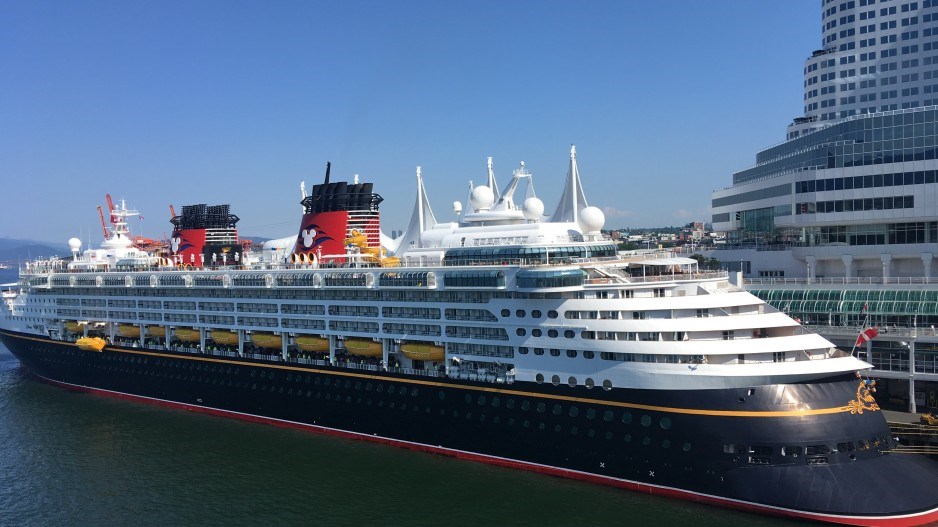Pollution from cruise ships would have, perforce, dropped dramatically in 2020, thanks to a pandemic that resulted in travel bans.
The cruise ship season in 2020 was largely non-existent.
“That reprieve may soon come to an end as Carnival Corporation and other cruise companies are preparing for business as usual in 2021,” warns Stand.earth and the West Coast Environmental Law (WCEL).
That would be good news for B.C. businesses hit hard in 2020 from the loss of cruise ship business.
But it’s not good news for the ocean, says a new study published by Stand.earth and WCEL.
The report finds Canadian laws are too lax when it comes to the sewage, greywater and scrubber discharges that are allowed in Canadian waters off the coast of B.C. It’s the latter – scrubber washwater – that may be the discharge of most concern.
The report suggests cruise ships plying waters between Washington and Alaska are using B.C. as their “toilet bowl” because Canadian federal regulations governing discharges are not as strict as state regulations in Alaska and Washington.
“From California to Alaska, coastal jurisdictions are leading the way in protecting Pacific waterways from cruise ship pollution – except Canada, where cruise ships annually dump more than 31 billion litres of ocean pollution,” a Stand.earth and WCEL news release states.
Except that’s not quite what the report says. That 31 billion litres of pollution is what theoretically is allowed to be discharged. No one knows for sure that cruise ships are dumping that much wastewater in B.C. coastal waters.
There appears to be a lack of monitoring and reporting that would allow the actual volume discharged to be quantified – something that could be addressed if the federal government insisted on on-board observers, as is required in Alaska.
The report’s authors conjecture that cruise ships must be dumping a lot of treated sewage, greywater and scrubber washwater in Canadian waters because the rules are so tight in Washington and Alaska that there’s no way cruise ships could store all that waste without dumping it somewhere on their trips between the two states. Presumably that somewhere is coastal B.C.
“Canada, with its weak regulations and lack of monitoring, is almost certainly the preferred dumping grounds,” the report states.
“I would say it’s a very educated conjecture,” Michael Bissonnette, a lawyer with WCEL, told BIV News. “We don’t actually have an independent observer monitoring programs in Canada on cruise ships like they do in Alaska, and if we did have that, we would probably have much better data on exactly the amount and where these sewage and other wastewater is being dumped.”
A cruise ship leaving Washington State would pass through a no-discharge zone until it reaches Canadian waters. When it gets to Alaska, it would need to obtain a dumping permit to discharge water in Alaskan coastal waters.
“A lot of the ships that are going up the coast are actually not obtaining those permits to dump in Alaskan waters,” Bissonnette said. “So, it seems very reasonable to suggest that they are keeping their water for those areas [Canadian waters].”
There are three types of discharges from cruise ships that are allowed under various federal and state permits: treated sewage, greywater, and washwater from scrubbers.
Cruise ships must have some form of treatment system for sewage, so any sewage discharges from them may be cleaner than that discharged into the ocean by some municipal or regional governments.
In response to questions, the Cruise Lines International Association (CLIA) said the Advanced Wastewater Treatment Systems being installed in cruise ships “rival the best shoreside treatment plants.”
About 78% of cruise ships have these systems in place, according to CLIA, and 99% of the new ships on order will have them.
It’s the washwater from scrubbers that may be a bigger concern, because they account for the largest volume.
These scrubbers are being installed in many ocean-going vessels to meet new International Maritime Organization (IMO) limits on sulphur emissions that came into force in 2020.
“The great bulk of the wastewater that’s being generated from these ships is with those scrubbers,” Bissonnette said.
He added that about 95% of any wastewater discharges from cruise ships would be from scrubber washwater.
For many shipping companies, these scrubbers are the cheapest and easiest way of meeting the new IMO regulations. They allow ships to continue burning cheap marine bunker fuel.
The scrubbers don’t really eliminate the SOX and particulate pollution – they just shift it from the air to the ocean.
“Scrubber washwater is laden with heavy metals, polycyclic aromatic hydrocarbons (PAHs), thermal pollution and is highly acidic,” said Anna Barford, Stand.earth’s Canadian shipping campaigner. “Heavy metals and PAHs are persistent in the marine environment, and accumulate in the food chain.”
“What we are calling for is Canada to follow California’s leadership on this and to outlaw scrubbers and instead have cruise ships just instead adopt cleaner sources of fuel,” Bissonnette said.
Even diesel is cleaner than marine bunker fuel and can be burned without engine retrofits. LNG is cleaner still. For new builds, the cruise sector is commissioning new ships to run on LNG.
“This is a very new technology, but already 49% of new cruise capacity on order will rely on LNG for primary propulsion in the future, a huge step in the right direction,” CLIA says.
Stand.earth and WCEL are calling on the federal government to tighten federal regulations and make a number of recommendations. They include requiring on-board observers and monitors, like the ones required in Alaska. This would at least allow the amount and locations of discharges to be quantified.
It also recommends designating no-discharge zones in sensitive areas.
Asked for a response to the report, the Ministry of Environment and Climate Change referred BIV News to Transport Canada, which has not yet responded.




